Exploring the Design and Functionality of Barn Door Latches
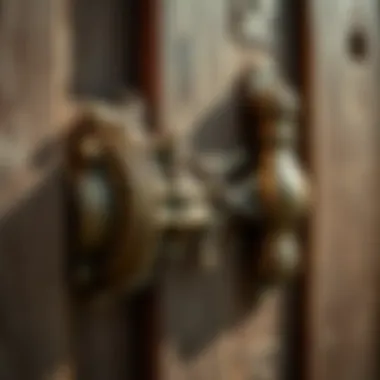
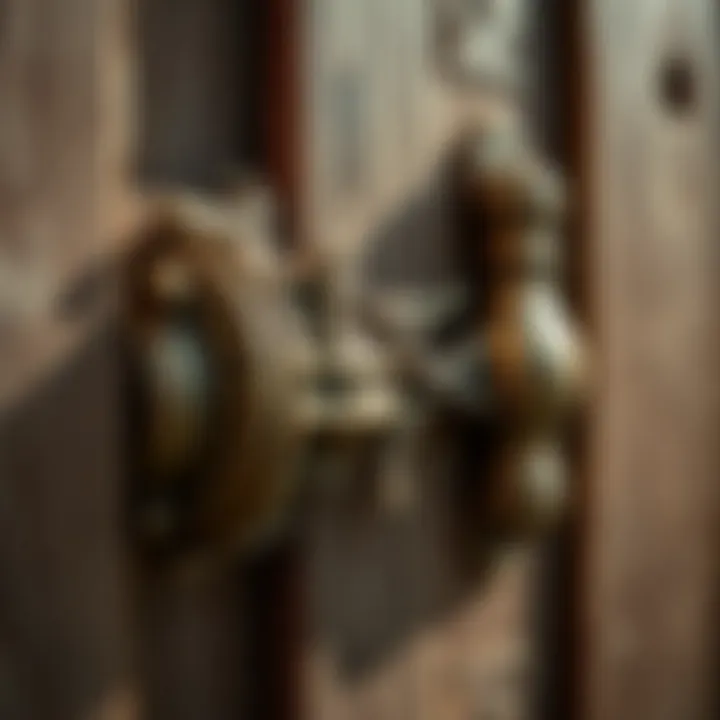
Intro
When one considers the humble barn door latch, it might seem a simple mechanism, yet its significance cuts deeper than the wood it fastens. At first glance, many might overlook the nuances of this functional accessory, but peel back the layers, and you'll find a rich tapestry woven with history, innovation, and practical applications. This article seeks to illuminate the different facets of barn door latches, from their design intricacies to their roles in both agricultural settings and decorative contexts.
In rural landscapes, barn doors swing open and closed, holding stories of agricultural toil, livestock care, and harvest seasons. Imagine standing in front of one of these sturdy constructions. The latch isn’t just a locking mechanism; it’s a symbol of security and tradition, often passed down through generations. Understanding the evolution of barn door hardware can offer insight into the agricultural practices of yesteryears, as well as inform choices for contemporary setups.
As the world advances, so too do the tools we utilize. Recent trends spotlight innovative materials and designs that merge functionality with aesthetic appeal. Whether in a rustic farmhouse or a modern agricultural facility, the relevance of barn door latches persists, adapting to the times while maintaining their essential role in everyday use. Just as farmers have adapted their practices in response to the land, so too have barn door latches transformed to serve various purposes in our changing world.
Exploring the essential terminology and historical perspectives surrounding barn door latches lays the groundwork for a broader understanding. This knowledge serves not only enthusiasts of agriculture and design but also those looking to harness the practical benefits these fixtures offer.
Let’s embark on a journey through the key concepts and terminology that define barn door latches, uncovering the history, innovation, and practical applications that continue to shape their use today.
Historical Background of Barn Door Hardware
Understanding the historical context of barn door hardware is akin to peeling back the layers of time. It reveals how these simple yet intricate devices have moved from functional tools in agricultural settings to becoming key elements in modern architectural designs. When one thinks of barn doors, it is easy to visualize rustic countryside scenes, but beneath these images lies a rich history that is often overlooked.
Evolution Through the Ages
The journey of barn door latches and hardware is a fascinating tale of innovation and practicality. Traditionally made from wood or iron, these latches have evolved significantly over the centuries. In the early days, farmers relied on simple mechanisms that were not only easy to craft but also effective in securing their barns.
Initially, wooden latches were crafted from locally sourced timber. The simplicity of their design, often consisting of a flat piece of wood that slid vertically or horizontally into a groove, made them accessible to many. However, as societies progressed, the demand for more durability brought iron into play.
With the advent of the industrial revolution, mass production of metal latches transformed availability and affordability. Designs became more complex, integrating softer lines and enhanced functionality. For instance, hook and eye latches gained popularity, facilitating quick access while also ensuring security. Over time, various regions developed their distinct styles, influenced by cultural preferences and functional needs.
"Each latch tells a story of its maker, a narrative forged in wood and metal, encapsulating the essence of the era and environment it served in."
Cultural Significance of Barn Door Latches
Barn door latches transcend their utilitarian purpose; they have become symbols of tradition and craftsmanship. For many communities, a well-crafted latch represents more than just security; it embodies heritage and the collective identity of families or regions. In rural America, for instance, barn doors adorned with unique latches can illustrate generational ties, showing how craftsmanship was passed down through families.
Moreover, in various cultures, these latches have been part of rituals and celebrations. Consider a new barn construction where the first latch is ceremoniously installed to symbolize protection and good fortune for the future. It is this blend of function and symbolism that elevates barn door latches from mere hardware to cultural relics.
Recognizing the deeper meanings behind these hardware elements allows us to appreciate them more fully. In contemporary times, many artisans have returned to crafting latches with cultural significance in mind, choosing styles that resonate with their community’s history and identity. Thus, these devices not only clasp doors but also weave connections among people, history, and art.
The exploration of the historical background of barn door hardware offers invaluable insights into both the past and present. Understanding its evolution and the cultural significance provides a richer context for appreciating these simple yet profound tools.
Understanding the Functionality of Barn Door Latches
Understanding the functionality of barn door latches is crucial for anyone involved in their use or installation. These seemingly simple devices play a pivotal role in not just securing entrances, but also in maintaining the overall aesthetic and practicality of barn-wise structures. Latches, often overlooked, are integral to the seamless operation and safety of barn and stable doors.
When one thinks about a barn door latch, it’s easy to assume it simply keeps the door closed. However, their importance stretches beyond this basic function. A well-designed latch enhances usability, ensures safety, and can even contribute to the longevity of the door itself. This discussion dives into how these mechanisms function and why they matter.
Mechanisms at Work
The inner workings of barn door latches can vary quite a bit depending on their type. Essentially, each latch employs mechanisms that fulfill the fundamental role of securing a door while allowing for quick access when needed. Most latches are designed with a few common components:
- The latch bar: This is the part that moves to lock and unlock the mechanism. It can be lifted or slid based on the design.
- Mounting plate: This element serves as the fixed point on which the latch is secured. It often determines the alignment and overall effectiveness of the latch type.
- Catch: This is the counterpart to the latch bar, allowing it to fit snugly for a secure closure.
Taking the hook and eye latch as a prime example, it uses a straightforward mechanism where a hook (the latch) engages with an eye (the catch) to keep the door secure. While its function seems fundamental, attention to detail during installation (such as ensuring alignment between the hook and eye) is crucial. An improperly installed latch not only can lead to inconvenience but may also compromise safety.
Advantages of Using Latches
Incorporating latches into barn doors lends a plethora of benefits that can significantly enhance the usability and security of agricultural buildings. Here are some advantages:
- Security: The primary benefit is undoubtedly security. A reliable latch ensures that the doors cannot be easily opened by unwelcome visitors.
- Ease of Access: Unlike other locking mechanisms, latches often allow for convenient operation from both inside and out, making it simple for users to enter and exit swiftly.
- Versatility: Available in a variety of designs, latches can accommodate different styles and sizes of doors, catering to personal preferences and functional needs.
- Aesthetic Integration: When a latch is selected thoughtfully, it can complement the overall design of the barn. A rustic wooden latch can add to the charm of a classic barn setup.
- Maintenance Simplicity: Most latches require minimal maintenance compared to more complex locking systems, reducing the burden on farmers or caretakers tasked with ongoing upkeep.
In short, making the right choice in latches can greatly affect the functionality and visual appeal of barn doors. It’s about finding that sweet spot where practicality meets aesthetic considerations, crafted into a functional and durable solution that enhances both utility and design.
"Choosing the right barn door latch is not just about looks; it’s about function, safety, and ensuring ease of access when you need it most."
For further exploration of styles and options, consider visiting resources such as Wikipedia or platforms like Reddit that have discussions about home improvement and barn aesthetics.
Types of Barn Door Latches
When it comes to barn door latches, understanding the different types is crucial. Each design serves a distinct purpose and offers unique benefits. Having the right latch can enhance both functionality and aesthetic appeal, a consideration for many farmers and design enthusiasts alike. In this section, we will explore the various types of barn door latches that are commonly used, highlighting their characteristics and applications.
Sliding Latches
Sliding latches are a simple yet effective option for securing barn doors. Typically made from metal or robust plastic, these latches slide into a catch to lock the door in place. One of their most significant advantages is their ease of use; you can quickly open and close a sliding latch with just one hand. Additionally, they require minimal hardware and often come in various styles, making them a versatile choice for different settings.
However, one thing to ponder is that sliding latches may need regular adjustments to stay aligned, particularly in areas with fluctuating temperature or humidity. Proper installation can mitigate misalignment and ensure smooth operation.
Hook and Eye Latches
These latches employ a straightforward mechanism, incorporating a hook that secures into an eye. Hook and eye latches are particularly favored for their simplicity and affordability. They can be made from various materials, such as stainless steel or brass, both of which offer durability and resistance to rusting.
Generally, these latches work well for lightweight doors, including those found in barns or sheds. However, for added security, it might be beneficial to pair hook and eye latches with a locking mechanism. Particularly in busy agricultural settings where livestock might try to escape, this added layer of security can be a real game-changer.
Barrel Bolts
Barrel bolts provide a more robust locking mechanism than some other latch types. This style consists of a cylindrical bolt that slides through a bracket, securing the door tightly. Barrel bolts are frequently used in barns due to their strength and reliability. They come in various sizes, allowing you to choose one that suits your door size and security needs.
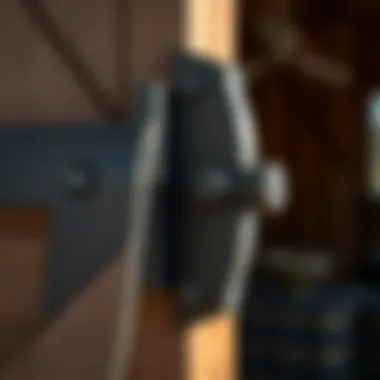
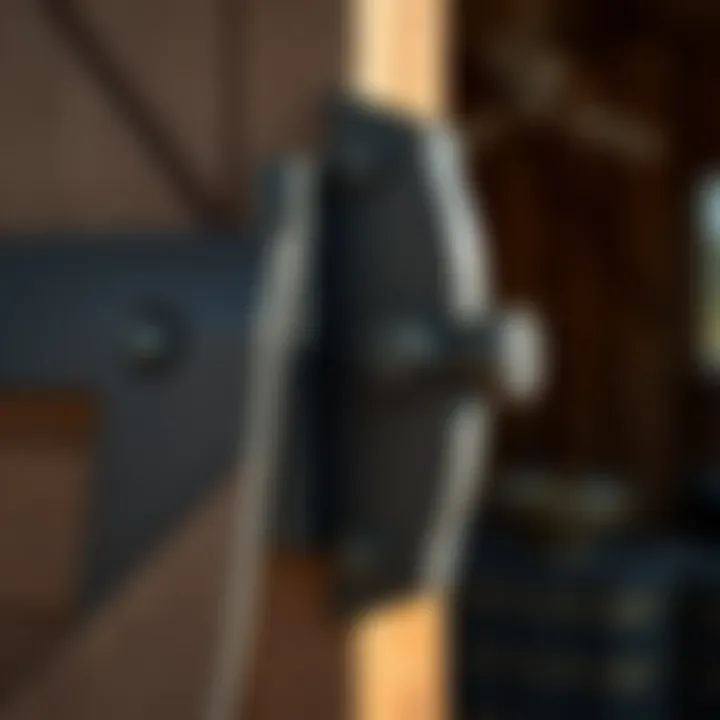
On the downside, installation requires precision to ensure smooth operation. Failure to align the bolt correctly can lead to a sticking door, requiring additional work to fix. Despite this, once installed correctly, a barrel bolt will serve you faithfully for a long duration.
Spring-Loaded Latches
Spring-loaded latches are designed for quick and convenient access, often found in high-traffic areas where speed is essential. These latches automatically engage when the door is closed, providing a hassle-free locking solution. Many farmers appreciate this feature, especially when their hands may be full. The flexibility and responsiveness of these latches make them particularly useful for barn applications.
However, it is crucial to note that spring-loaded latches can sometimes be prone to wear and tear, especially if subjected to constant use or external elements. Regular checks and occasional replacements might be necessary to ensure ongoing reliability.
Each type of barn door latch offers its own strengths and weaknesses, and choosing the right one is essential for ensuring the safety and functionality of your barn space. Whether you're looking for straightforward installation or a more intricate locking mechanism, there's a latch out there tailored for your specific needs.
Materials Used in Barn Door Latch Manufacturing
The choice of materials in barn door latch manufacturing plays a key role in defining the durability, effectiveness, and aesthetic appeal of these essential components. Selecting the right material not only affects the functionality but also has implications for maintenance practices and long-term usage. Understanding various materials helps farmers and enthusiasts alike make informed decisions that enhance the operation of their barn doors while also harmonizing with the surrounding environment.
Wooden Latches
Wooden latches have a long-standing tradition in barn door hardware. Naturally, wood is abundant and easy to work with, making it a popular choice, especially in rural settings. The warmth and texture of wood can complement rustic architecture, giving structures a charming, timeless quality.
However, wooden latches do come with their set of challenges. They are susceptible to moisture, leading to potential rot or warping over time. Therefore, proper treatment and an occasional coat of protective finish can extend their life. Additionally, wooden latches might not provide the same level of security that metal options offer, which can be a concern for many.
“You can’t judge a latch by its cover; functionality counts just as much as aesthetics.”
Metal Latches
Metal latches, which include materials such as stainless steel, brass, or wrought iron, offer a stark contrast to their wooden counterparts in terms of durability and security. With the ability to withstand harsh weather and heavy usage, they are often favored in both traditional barns and modern settings.
The benefits of metal latches are numerous. For one, they require less maintenance compared to wood, typically just needing occasional cleaning to maintain their shine and resist corrosion. Moreover, metal latches can be designed in various styles, from sleek and modern to ornate and vintage. This versatility allows homeowners and farmers to match or contrast with their barn door styles effectively.
Yet, one must consider the potential for rust in certain metal types, particularly if they are not adequately treated. Regular inspections can help catch any signs of wear before they become a problem.
Composite Materials
In recent years, the introduction of composite materials has changed the landscape for barn door latches. Composites, made from a mix of plastic, wood fibers, or other materials, offer the best of both worlds—durability and aesthetic quality. These materials are crafted to resist moisture and are often environmentally friendly, which resonates with the current push toward sustainable practices.
The key advantages of composite latches include their lightweight nature and resistance to warping or cracking. They also come in various colors and textures, making it easier to find a latch that fits your specific design goals without sacrificing performance.
While composite latches may not offer the same traditional touch as wood or the robust feel of metal, they are proving to be an innovative and practical choice for modern barns that still cherish aesthetic and functional integrity.
Installation Procedures for Barn Door Latches
The installation of barn door latches is not just a mechanical task; it plays a crucial role in ensuring the latch functions effectively and securely. This section highlights why proper installation matters, what steps to consider, and how to achieve a smooth setup without a hitch. Whether you’re adding character to your farmhouse or tightening security on a commercial property, getting the installation right is key.
Preparation and Planning
Before any tools touch wood, preparation is essential. It’s like laying out the groundwork for a solid foundation — you wouldn’t build a house on sand, right? Here’s what to consider:
- Assessing Door Type: Not all barn doors are created equal. Knowing the type of door you have—be it sliding, hinged, or bi-fold—is vital. Each presents a unique challenge and opportunity for latch compatibility.
- Choosing the Right Latch: Latches come in various styles, such as sliding latches or hook and eye options. Choosing a latch that complements not only the door's aesthetics but also its function is smart.
- Gathering Tools and Materials: Prepare everything you need before your hands get dirty. Standard tools include a drill, screws, a level, and a tape measure. Having everything within arm's reach makes the job more efficient.
- Reviewing Instructions: Every latch has its own set of guidelines. Don’t just skim over them; a careful review can save you from mistakes down the line. They often contain specific tips about positioning and screw sizes.
Doing your homework here means you’ll not only make the job easier, but likely avoid headaches later on.
Step-by-Step Installation Guide
Now that you are prepped, let’s dive into the nitty-gritty of installation. Following a systematic approach can ensure that your latch not only works as intended but also lasts.
- Mark the Placement: Use a pencil to mark where you want the latch on the door. A good rule of thumb is to place it at handle height for ease of access.
- Drill Pilot Holes: Before driving in screws, drill pilot holes to avoid splitting the wood. Smaller holes allow for better alignment and a smoother installation.
- Attach the Latch Body: Screw the latch body into place first. Ensure it is level; there's no reason to end up with a crooked latch.
- Position the Strike Plate: Close the door to see where the latch meets it. Mark the strike plate's position clearly, then drill pilot holes again before attaching it.
- Test the Mechanism: Once everything is affixed, it’s crucial to test the latch. Open and close the door several times to ensure the latch engages smoothly and securely. If it sticks or does not latch properly, reassess your alignment.
- Final Adjustments: If necessary, make adjustments to any screws and ensure tightness. A shift during installation could leave your latch functioning poorly.
Even a seasoned expert knows that a steady hand and a little patience go a long way during installation. Taking time to set up correctly ensures functionality, safety, and a dash of peace of mind.
"Quality installation translates to years of reliable service. Don’t rush the process; it pays off in the long run."
By following these methods, you not only equip your barn doors with the security they need but also enhance their aesthetic appeal. Feeling lost? Reach out to resources such as Wikipedia or Britannica for additional guidance. The wealth of knowledge available will surely assist you in your DIY endeavors.
Maintenance and Care of Barn Door Latches
Maintaining barn door latches is crucial for their longevity and reliability. Without proper care, even the sturdy hardware can become susceptible to problems, which can impede functionality and lead to safety concerns. In an agricultural setting, where these latches are frequently exposed to the elements and heavy use, regular maintenance not only enhances the practical utility of the latches but also contributes to the overall aesthetic appeal of the barn door. Ensuring that latches operate smoothly can save farmers from major headaches and costly replacements down the line.
Regular Maintenance Tips
To keep barn door latches in optimal condition, there are some straightforward maintenance tasks that can be performed routinely:
- Clean the Latches: Dirt and grime can accumulate over time. Clean the latch with soapy water and a soft cloth, ensuring all moving parts remain free of debris.
- Lubrication: Apply a suitable lubricant, like lithium grease or silicone spray, to the moving parts at least twice a year. This reduces friction and prevents rust.
- Check Screws and Bolts: Periodically inspect all screws and bolts, tightening them as necessary. Loose hardware can compromise the latch function.
- Seasonal Inspections: Every spring and fall, do a thorough inspection of the latches. Change of seasons can introduce moisture and dirt, causing issues that need to be addressed promptly.
Implementing these tips ensures the barn door latches function correctly and reduces the risk of sudden failures.
Identifying Wear and Tear
Recognizing signs of wear and tear is essential to maintaining the integrity of barn door latches. It’s not always easy, as some issues can be subtle, but there are notable indicators to watch:
- Rust Formation: Check for signs of rust, especially in metal latches. If you see rust, it could weaken the latch over time if not treated.
- Difficulty in Operation: If the latch becomes increasingly difficult to operate or does not close properly, it could mean that there is internal damage or misalignment.
- Visual Deterioration: Inspect for cracks, chips, or other damage on both wooden and metal latches. This could be a sign that it’s time to consider a replacement.
- Loose Components: A noticeable looseness in the latch or its housing can lead to ineffective operation. Addressing this early can prevent further complications.
Regular monitoring of these factors not only extends the life of your latches but ensures they remain effective in securing your barn doors. Whether you’re an agriculture farmer or a passionate hobbyist, keeping an eye on these details is bound to pay off.
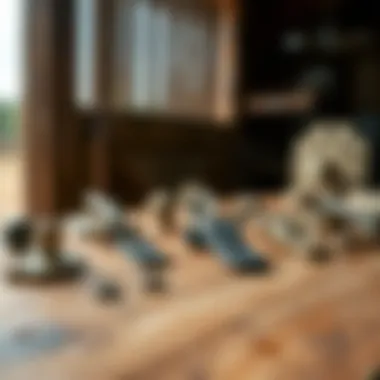
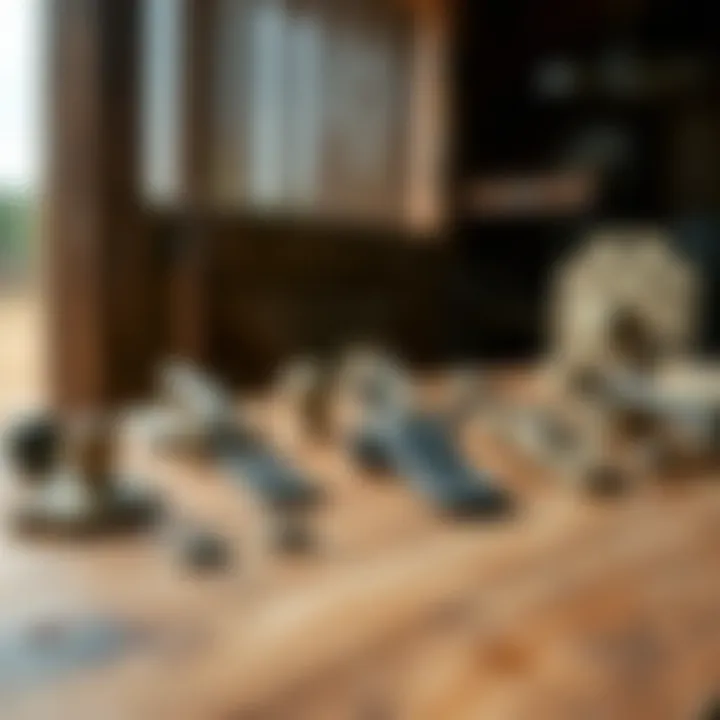
Aesthetic Considerations in Barn Door Latch Selection
Selecting the right barn door latch goes beyond mere functionality; it is also an art form. When it comes to barns, the latches serve not just as practical mechanisms but also as design statements that can tie together the entire aesthetic of a space. A well-chosen latch can complement the door's style and the surrounding architecture, enhancing the overall visual impact of the environment. This section will explore the interplay between latches and design, emphasizing key elements you should consider.
Matching Latches with Door Style
When it comes to matching a latch with a barn door, the devil really is in the details. The style of the latch should resonate with the door and building's design, whether it’s rustic or contemporary. For instance, traditional wooden latches crafted from weathered timber might harmonize beautifully with a solid oak sliding door, bringing a sense of heritage and warmth.
On the flip side, if your barn door is modern, opting for sleek metal finishes or minimalistic designs can offer a stark contrast and make the door stand out. Balancing these two aspects often requires a trained eye:
- Rustic Style: Favor iron latches that evoke an old-world feel. These might include intricate designs or a hand-forged appearance.
- Modern Style: Consider fitting your door with a streamlined latch made from brushed stainless steel, which brings a sophisticated edge to simplicity.
It's important to consider both functionality and form.
"A barn door latch is more than a mechanism; it's a conversation starter, an element that can narrate the story of your space."
Color and Finish Options
Color and finish play critical roles in how a latch integrates visually with the door. Just as you wouldn't slap on any old color to walls without thinking about the overall palette, the same thought must go into latch selection. Colors should either complement or contrast effectively:
- Complementary Colors: A latch in a warm bronze finish can elevate a door of a deep mahogany, creating a seamless flow of hues.
- Contrasting Colors: Alternatively, a bold black latch can serve as a striking counterpoint against a pastel-blue door, adding vibrancy and flair.
There’s also the question of how finishes respond to the surrounding environment. Outdoor latches, for example, should be weather-resistant—powder-coated or treated finishes that resist rust and corrosion are ideal.
In summary, the aesthetic considerations surrounding barn door latches bridge the gap between utility and artistry. By paying careful attention to how latches match door styles and the effects of color and finish, you can create a cohesive look that stands the test of time both practically and visually.
Safety Considerations
When it comes to barn door latches, safety is a paramount concern, especially in agricultural and residential settings. Effective latching mechanisms not only secure doors but also prevent mishaps that could lead to injury or property damage. Understanding safety considerations is crucial, as these latches often play a pivotal role in the overall integrity of spaces they safeguard.
Preventing Accidental Openings
Accidental door openings can lead to all sorts of trouble, especially on a farm where livestock can escape or equipment can be accessed by unintended individuals. This underlines the necessity for barn door latches that offer reliability and design elements meant to minimize such risks. A well-selected latch will resist being inadvertently triggered by wind, curious animals, or even careless human activity.
To mitigate the risks of accidental openings, consider the following strategies when selecting a barn door latch:
- Choose a latch with a secure locking mechanism: Latches that feature a turn latch or locked hook are less likely to be accidentally disengaged compared to simpler models.
- Opt for heavier materials: A metal latch, for instance, often provides enhanced stability and ensures the door remains securely closed against bumps or knocks.
- Install additional barriers: A secondary latch or slide bolt can offer double protection, thereby significantly reducing the likelihood of an unwanted opening.
"A sturdy latch not only keeps things secure but also saves time and trouble down the line." Despite the best intentions, accidents happen, and relying solely on one mechanism may expose vulnerabilities.
Choosing Latches for Secure Enclosures
In a world where safety can't be compromised, choosing the right latch for secure enclosures should be approached with care and consideration. Not every latch will suit all types of barn doors; therefore, understanding the specific needs of the enclosure is key. Whether it's a livestock barn, tool shed, or grain storage, a secure latch keeps your resources from falling into the wrong hands.
Here are important factors to contemplate when selecting latches for secure enclosures:
- Assess the Environment: Weather conditions play a massive role in latch longevity and effectiveness. In rainy or humid conditions, consider materials treated for corrosion resistance.
- Analyze Security Ratings: Some latches come with security ratings that indicate their robustness. Latches with higher ratings provide added peace of mind in terms of break-in resistance.
- Size and Fit: Ensure the latch mechanism is fit for the door size, and size matters. An ill-fitted latch may create gaps, making it easy for intruders to gain access.
- Incorporate Smart Features: For those who are inclined towards tech-savvy options, smart latches featuring remote unlocking or monitoring capabilities can substantially enhance security without the need for physical keys.
Innovations in Barn Door Latch Design
The landscape of barn door latch design has transformed significantly with the advent of modern technology and increasing environmental awareness. While earlier latches focused primarily on functionality, today's latches are not just devices for securing doors; they represent a blend of aesthetic appeal and cutting-edge innovation. Understanding thes developments is crucial for anyone in the agricultural sector or those involved in modern architecture, as it intertwines operational efficiency with contemporary design philosophy. Therefore, innovations in barn door latch design not only offer practical benefits but also enhance the overall value of any agricultural or residential property.
Smart Technology Integration
The integration of smart technology in barn door latches is a game changer. As homes and farms become increasingly automated, latch systems are following suit. Imagine a latch that you can control remotely or one that can sense when it's being opened. This convenience is not just a luxury; it offers enhanced security measures. For example, some smart latches allow for keyless entry through smartphone apps or biometric scanning, eliminating the need for traditional keys that can be lost or misplaced.
- Benefits:
- Increased security through advanced locking mechanisms.
- Convenience of remote access and management.
- Ability to monitor and track usage patterns, providing valuable insights for operation.
However, it’s important to consider compatibility with existing systems and the overall durability of these smart devices, especially in agricultural settings where dust, moisture, and varying temperatures can be an issue.
Eco-Friendly Materials and Construction
Sustainability is no longer just a buzzword; it’s becoming a necessary consideration in every aspect of design and construction. When it comes to barn door latches, eco-friendly materials like recycled metals and sustainably sourced woods are making headway. This shift not only reduces the environmental footprint but also appeals to consumers who are more aware of their choices.
- Considerations in eco-friendly latch design:
- Use of recycled metals—or even biodegradable materials—decreases waste.
- Sourcing certified wood ensures responsible forestry practices.
- Durability is also key; sustainable materials should not compromise longevity and effectiveness.
Using these materials aligns with the broader agricultural and residential initiatives aimed at reducing unnecessary waste, appealing to environmentally conscious farmers and homeowners alike who seek to enhance their ecological impact while maintaining functionality and style.
Innovations in design combined with a commitment to sustainability represent a forward-thinking approach that can redefine the role of barn door latches.
Common Challenges and Solutions
When it comes to barn door latches, a few common challenges crop up more often than not. Knowing how to tackle these issues can save time, frustration, and perhaps a bit of money in the long run. Not only do these challenges affect functionality, but they can also have an impact on the aesthetic and security aspects of barn doors. Enhancing the understanding of these challenges and their solutions will allow farmers and enthusiasts alike to enjoy the full benefits of their barn door systems.
Addressing Misalignment Issues
Misalignment is a pesky problem in barn door latches that, if left unchecked, can lead to a host of headaches, from difficult operation to complete failure of the latch mechanism. Consider a scenario: you’ve just finished painting your barn door, making it a dazzling shade of red. However, due to the settling of the structure or a previous installation misstep, the latch no longer aligns properly with its counterpart on the frame.
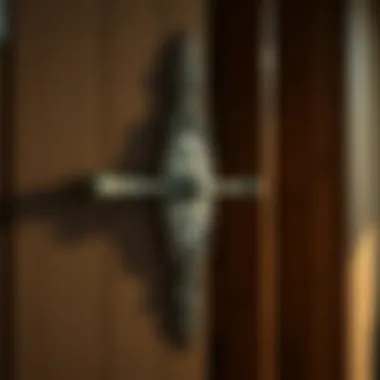
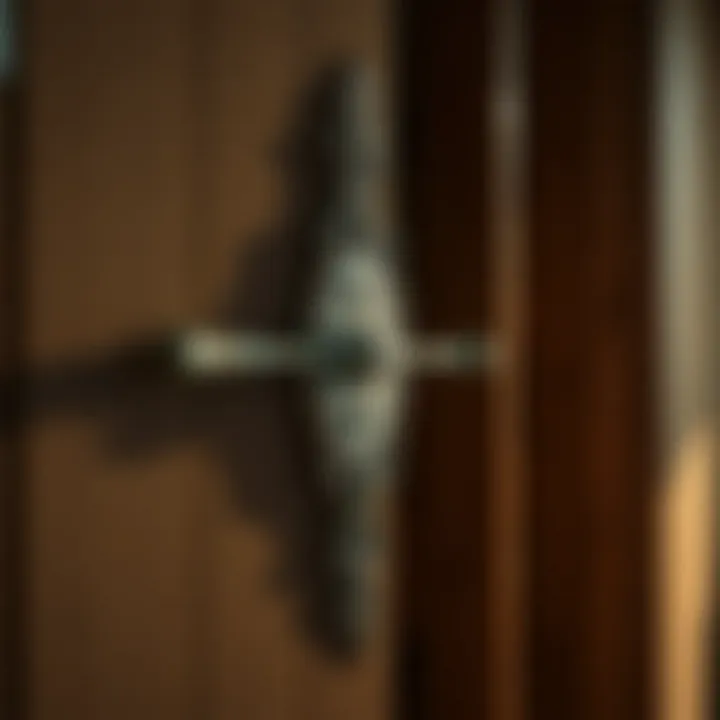
The implications can be significant. First, if the door doesn’t close fully, it may create an opening for pests or even larger animals, like raccoons, looking for an easy meal. Misalignment can also cause wear on the latch over time, leading to early replacement.
Here are a few tips to handle misalignment:
- Inspect and Adjust: Take a close look at the latch and the strikes. Sometimes, it just requires a simple adjustment. Loosen the screws slightly, shift the latch plate, and tighten them again.
- Regular Maintenance: Periodic checks are key. A few minutes inspecting the latch can help catch any misalignment early before it becomes a bigger issue.
- Consider Professional Assistance: If it's a persistent problem, it might be prudent to consult a carpenter or handyman to ensure everything is aligned properly.
Resolving Sticking or Jamming Problems
The last thing you want when trying to quickly secure your barn door is to deal with a latch that sticks or jams. Picture this: You’re trying to close up for the night, and you find yourself wrestling with a stubborn latch that just won’t budge. Frustrating, right? Sticking or jamming can arise from various causes including dirt accumulation, humidity changes, or simply a misfit within the parts.
Here’s how to troubleshoot sticking or jamming:
- Clean the Mechanism: Regular cleaning is vital. Dust, dirt, and debris can hinder smooth operation. Use a brush or cloth to clean the latch and surrounding areas.
- Lubricate: One of the simplest yet most efficient solutions is to apply a suitable lubricant like silicone spray. Just a small spray can keep things gliding smoothly.
- Check for Warping: Wood can expand or contract with humidity. If your latch is jamming in wet weather, look for any warping that might necessitate replacement.
Each of these suggestions can foster longevity and optimal performance of barn door latches, ensuring that they fulfill their vital roles in safeguarding and beautifying agricultural spaces. Maintaining awareness of such challenges and knowing how to resolve them can lead to more enjoyable use and aesthetic appeal of barn doors.
"A well-maintained latch is not just a door accessory; it offers peace of mind and style to any barn."
For more tips and tricks, you can check resources like Wikipedia or Britannica. These can provide expanded insights into the styles and uses of barn door hardware.
Barn Door Latches in Modern Architecture
Understanding the role of barn door latches in modern architecture is crucial, as these elements blend functionality with aesthetic appeal. They symbolize practicality rooted in tradition while embracing contemporary design principles. As architects and homeowners look to achieve a seamless mix of the old and new, barn door latches have emerged as important accessories that not only serve a purpose but also contribute to the overall ambiance of a space.
The significance of barn door latches can be broken down into several key elements. Firstly, they provide effective closures for doors, ensuring security and convenience in various environments. Secondly, the design diversity in these latches allows for creative expression in homes and commercial spaces alike. Lastly, the shift towards sustainable materials has prompted innovative latch designs that are eco-friendly, making them even more desirable.
Applications in Residential Spaces
Barn door latches have found their way into residential spaces, particularly in homes designed with an open-concept layout. These latches can transform a plain doorway into an intriguing focal point. In this context, a sliding barn door elegantly outfitted with a well-crafted latch not only serves practical purposes but also enhances visual interest. Consider the use of a rustic iron latch on a reclaimed wood door. It evokes a charm that resonates with many homeowners yearning for a warm, inviting atmosphere in their living spaces.
Furthermore, barn door latches are increasingly used in unique areas such as bathrooms, closets, and even kitchens. A cleverly designed latch can make a sliding door a standout element. By selecting latches that harmonize with the door style and finish, homeowners create cohesive looks that enhance the character of their spaces.
Incorporation into Commercial Designs
In commercial architecture, barn door latches are also gaining momentum. They offer versatile options for office spaces, restaurants, and shops, where separating areas may require visually appealing solutions. For example, a trendy café might use barn doors with stylish latches to partition a seating area, crafting a cozy yet functional environment.
In retail settings, barn door latches add character to storefronts, lending authenticity to the brand's image. They resonate with customers seeking unique experiences over mundane ones. By integrating these traditional elements, businesses can create an environment that feels both inviting and aligned with modern design trends.
Adopting barn door latches in commercial spaces gives an opportunity to use various materials such as steel, brass, or even sustainable wood. Such choices reflect a brand’s commitment to quality and aesthetic values. This is particularly important for eco-conscious businesses aiming to attract customers who prioritize sustainability in their purchasing decisions.
Overall, barn door latches serve as a versatile component in modern architecture, bridging the gap between heritage and contemporary style, and they play a crucial role in residential and commercial applications alike. As trends continue to evolve, their importance in design will likely grow, presenting endless possibilities for creativity and functionality.
Cost Considerations
When it comes to barn door latches, understanding the financial implications is crucial for farmers and enthusiasts alike. Cost considerations play a significant role in selecting the right hardware for both practical use and aesthetic appeal. It is not just about the initial price of the latch; it involves understanding the complete picture, including longevity, maintenance costs, and the overall return on investment.
Understanding Price Variability
The market is rife with various barn door latch options, leading to noticeable price differences. Factors influencing these costs include:
- Material Choices: The composition of a latch, whether it's wood, metal, or a composite material, greatly affects its price and durability.
- Brand Reputation: Established companies often charge more due to their reliability and quality assurances. A latch from a reputable brand may be more expensive upfront but might save money in repairs or replacements later.
- Design Complexity: Some latches come with advanced features or unique designs, commanding higher prices. Then again, simplicity often translates to reliability.
For instance, a basic sliding latch may average around $10, while a smart latch with tech integration can soar to $100 or more. Knowing your needs can help in making the right decision.
Budgeting for Quality Latches
When budgeting for barn door latches, it’s wise to consider more than just their purchase price. Here’s a brief breakdown of areas that warrant attention:
- Lifetime Costs: Assess how long you expect the latch to last given its material and usage. Durable metal latches might last years more than their wooden counterparts, leading to long-term savings.
- Installation Expenses: Sometimes, the prices do not include installation. Hiring a professional can ramp up your total costs, so factor this into your budget.
- Maintenance Needs: Certain materials require more upkeep. Wooden latches may need regular treatment to resist rot, while metal counterparts might need rust prevention measures.
"A penny saved is a penny earned," they say. Investing in quality upfront can prevent headaches and expenses down the road.
Aligning your budget with your needs is key. Consider a two-pronged approach—choose latches that fit your budget but also prioritize quality and functionality. This strategy ensures that your choice will not only satisfy immediate needs but will serve well for years to come.
Overall, cost considerations should be a blend of economic sense and an understanding of quality. It’s about finding a balance that fits both your wallet and your operational needs.
The Role of Barn Door Latches in Sustainability
Sustainability encompasses a conscious approach to resource management, encouraging practices that reduce environmental impact. In the context of barn door latches, sustainability goes beyond just functionality. It intertwines durable design and thoughtful material selection, ensuring that these hardware components not only serve their purpose but also contribute positively to the environment.
A well-crafted barn door latch can enhance operational longevity, minimize waste, and promote eco-friendly practices. Farmers and enthusiasts who understand this connection can make informed choices that reflect an eco-conscious mindset. This section explores how barn door latches play a crucial role in sustainable practices.
Promoting Longevity through Quality
Quality in the design and manufacturing of barn door latches is critical. Selecting latches that are robust and well-made means they can withstand exposure to the elements and the stresses of regular use. For instance, a latch constructed from high-grade stainless steel or premium hardwood offers significant benefits:
- Durability: High-quality materials resist rust, corrosion, and wear, resulting in a longer lifespan.
- Reduced Replacement Frequency: Fewer replacements over time lead to resource conservation.
- Cost-effectiveness: Although the initial investment might be higher, the long-term savings from avoiding frequent replacements and repairs makes it worthwhile.
"Investing in quality barn door latches is like planting a seed. With time and care, it yields benefits that far exceed the initial effort."
When farmers choose well-crafted latches, they not only secure their doors effectively but also commit to sustainability through responsible consumption. Furthermore, maintenance plays a role here; regular checks and upkeep can extend the lifespan of even the best latches, ensuring they operate smoothly for years to come.
Waste Reduction in Material Selection
Material selection is paramount in the journey toward sustainable barn door latches. Choosing materials with low environmental impact reduces waste associated with production and disposal. Here, contrasts can be drawn between traditional materials and modern alternatives.
- Recycled Materials: More manufacturers are introducing latches made from recycled metals and composites. This practice conserves natural resources and decreases landfill waste.
- Sustainable Wood: Utilizing wood from responsibly managed forests minimizes deforestation impacts. Certification systems like FSC (Forest Stewardship Council) ensure your wood sources are harvested sustainably.
- Bio-based Plastics: Some innovative manufacturers are exploring bio-based plastics, derived from renewable biomass sources. These materials can lessen reliance on fossil fuels and reduce carbon footprints.















